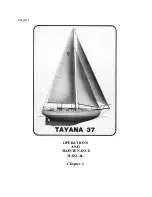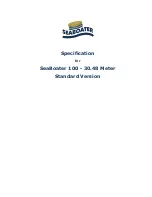
DECK SERIES OWNER’S MANUAL
49
|
P a g e
DECK SERIES
• When preparing to go around a bend that may obstruct your view of other water vessels, you should sound a prolonged
blast on the horn or with a whistle for four (4) to six (6) seconds. Even if no reply is heard, you should still proceed around
the bend with caution.
READING BUOYS AND OTHER MARKERS
The waters of the United States are marked for safe navigation by the lateral system of buoyage. The markers and buoys you
encounter will have an arrangement of shapes, colors, numbers, and lights to show which side of the buoy a boater should
pass when navigating in a particular direction. The Uniform State Waterway Marker System has been devised for these
waters. This system uses buoys and signs with distinctive shapes and colors to show regulatory or advisory information. The
markings on these buoys are oriented from the perspective of being entered from a seaward direction while the boater is
going toward the port. Red buoys are passed on the starboard (right) side when proceeding from open water into port, and
green buoys are passed on the port (left) side. When navigating out of port, your position to the buoys should be reversed:
red buoys to port (left) and green buoys to starboard (right).
Uniform State Waterway Marker System
Green or Black Channel Marker Buoy
: Traveling upstream, you should pass to the right of the buoy as it marks the left side
of the channel.
Red Channel Marker Buoy
: Traveling upstream, you should pass to the left of the buoy as it marks the right side of the
channel.
Junction Buoy (Green over Red)
: Means two channels are coming together and you should pass to the right of the buoy as
you travel upstream.
Junction Buoy (Red over Green)
: Means two channels are coming together and you should pass to the left of the buoy as
you travel upstream.
Passing Daymark (Green)
: A sign mounted on poles in the water or on the bank which is used in the same manner as a
channel marker buoy. In this case it marks the left side of the channel as you travel upstream.
Passing Daymark (Red)
: A sign mounted on poles in the water or on the bank which is used in the same manner as a channel
marker buoy. In this case it marks the right side of the channel as you travel upstream.
Channel Crossing Daymark (Green)
: A sign mounted on poles in the water or on the bank which means the channel is
crossing from the left bank to the right bank as you travel upstream.
Channel Crossing Daymark (Red)
: A sign mounted on poles in the water or on the bank which means the channel is crossing
from the right bank to the left bank as you travel upstream.
Boats Keep Out Buoy
: Marks a swimming area, an area near a dam or any area where boats are not allowed.
Danger Buoy
: Marks an obstruction, ferry cable, or any area where boats should not navigate or should use extreme caution.
Information Buoy
: Used to relay information. Words printed in black (usually inside the border) tell place names, distances,
directional arrows, availability of supplies, gasoline, etc.
Summary of Contents for Deck Series
Page 1: ...NAUTICSTAR DECK SERIES OWNER S MANUAL 193 SC 203 SC 203 DC 223 DC 243 DC 2022...
Page 22: ...DECK SERIES OWNER S MANUAL 22 P a g e DECK SERIES...
Page 52: ...DECK SERIES OWNER S MANUAL 52 P a g e DECK SERIES 203 SC...
Page 53: ...DECK SERIES OWNER S MANUAL 53 P a g e DECK SERIES 203 DC...
Page 54: ...DECK SERIES OWNER S MANUAL 54 P a g e DECK SERIES 223 DC...
Page 55: ...DECK SERIES OWNER S MANUAL 55 P a g e DECK SERIES 243 DC...
















































